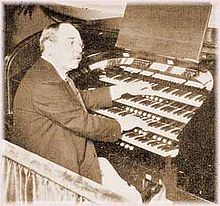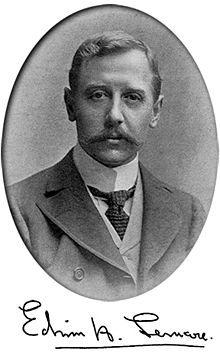Edwin Lemare
From Wikipedia, the free encyclopedia
| This article needs additional citations for verification. (September 2009) |
Contents
[hide]Biography[edit source | edit]
He was born in Ventnor, on the Isle of Wight, and received his early musical training as a chorister and organist under his father (a music seller, also called Edwin Lemare) at Holy Trinity Church. He spent three years at the Royal Academy of Music from 1876 on a Goss Scholarship, where he studied under Sir George Alexander Macfarren, Walter Cecil Macfarren, Dr Charles Steggall and Dr Edmund Hart Turpin. He obtained the F.R.C.O. in 1886. He became an organ professor and examiner for the Associated Board of the Royal Schools of Music in 1892.He gained fame by playing two recitals a day, over a hundred in total, on the one-manual Brindley & Foster organ in the Inventions Exhibition in 1884. He gave bi-weekly recitals at the Park Hall, Cardiff, from 1886; this was followed by further appointments around Great Britain.
After apparently treating church services in London as concerts, he left for a hundred-recital tour of the USA and Canada from 1900–1901, and stayed in North America for most of the remainder of his life. He also toured Europe, Australia, and New Zealand, where he helped to design the organs for Auckland Town Hall and Melbourne Town Hall. He died in Hollywood, California.
Organist posts held[edit source | edit]
- St. Mary’s, Brookfield, Highgate
- St. John’s, Finsbury Park, 1882
- Park Hall, Cardiff
- Sheffield Parish Church, 1886
- Albert Hall, Sheffield, 1886
- Holy Trinity, Sloane Street, London, 1892-1895
- St. Margaret's, Westminster, 1897-1902
- Carnegie Institute, Pittsburgh, 1902-1905
- Panama-Pacific International Exposition, San Francisco, 1915
- City Organist, San Francisco, 1917-1920
- Portland, Maine, 1921-1923
- Civic Organist, Chattanooga, Tennessee, 1924-1929
Abilities as organist and composer[edit source | edit]
As a player, he had a very large repertoire and was in constant demand; he was the most highly-paid organist of his day, and earned previously unheard-of sums when he went to America. He performed to as many as 10,000 people, and travelled the Atlantic so often that crew members of the ocean liners knew him by name. Some evidence of his excellent playing survives to this day: he made 24 player rolls for the Aeolian Company and 96 for Welte in Freiburg, which have been played again and recorded. He was also a very capable improviser; he recorded and transcribed some of his improvisations for publication.Of his many compositions for the organ, many are 'light music' designed to show off the tone and capabilities of the huge organs of his day, and have fallen out of favour (though Christopher Herrick has recorded much of Lemare's music in his Organ Fireworks series). Unusually, his qualities as a composer are generally thought to have declined rather than improved with age; his first two organ symphonies are considered to rival those of his French contemporaries in quality.
Moonlight and Roses[edit source | edit]
The Andantino in D-flat, known as Moonlight and Roses, op.83 no.2 (1888), is one of Edwin Lemare's few well-known original compositions. It became so popular that he was asked to play it in nearly all his concerts. It sold tens of thousands of copies, though he did not initially make any money out of it; when it was published in 1892 by Robert Cocks in London, he received a flat fee of three guineas. Lemare did not call it Moonlight and Roses nor did he attach any words to the tune; it was American songwriters Ben Black and Charles N. Daniels (under the pseudonym Neil Moret) who added these words to the melody, without permission, in 1921:Bring wonderful mem'ries of you.
My heart reposes
In beautiful thoughts so true.
June light discloses
Love's olden dreams sparkling anew,
Moonlight and roses
Bring mem'ries of you.
Compositions for organ[edit source | edit]
Published as The Organ Music of Edwin H. Lemare, edited by Wayne Leupold (Wayne Leupold Editions/E. C. Schirmer). Series I (Original Compositions): Volume I, II, III and IV; Series II (Transcriptions). He also composed church music and an orchestral symphony.Original[edit source | edit]
- Allegretto in B minor
- Andante Cantabile in F (Op. 37)
- Andantino in D flat (also known as “Moonlight & Roses”)
- Arcadian Idyll (Op. 52) (1: Serenade; 2: Musette; 3: Solitude)
- Barcarolle in A flat
- Bell Scherzo (Op. 89)
- Bénédiction Nuptiale (Op. 85)
- Berceuse in D
- Cantique d’Amour (Op. 47)
- Caprice Orientale (Op. 46)
- Chanson d’Été in B flat
- Chant de Boneur (Op. 62)
- Chant sans paroles in D
- Cloches Sonores (Basso Ostinato) - Symphonic sketch (Op. 63)
- Communion “Peace” (Op. 68)
- Concert Fantasia in F
- Concertstück No 1 - In the form of a Polonaise (Op. 80)
- Concertstück No 2 - In form of a Tarantella (Op. 90)
- Contemplation in D minor (Op. 42)
- Elegy in G
- Evening Pastorale “The Curfew” (Op. 128)
- Fantaisie Fugue in G minor (Op. 48)
- Fantasie Dorienne in the form of variations (Op. 101)
- Gavotte Moderne in A flat
- Gavotte à la cour (Op. 84)
- Idyll in E flat
- Impromptu in A
- Intermezzo : Moonlight (Op. 83/2)
- Intermezzo in B flat (Op. 39)
- Irish Air from “County Derry” (arr. by)
- Madrigal in D flat
- Marche Heroïque (Op. 74)
- Marche Solennelle in E flat
- Meditation in D flat (Op. 38)
- Minuet Nuptiale (Op. 103)
- Nocturne in B minor (Op. 41)
- Pastorale No 2 in C
- Pastorale Poem (Op. 54)
- Pastorale in E
- Rêverie in E flat (Op. 20)
- Rhapsody in C minor (Op. 43)
- Romance in D flat
- Romance in D flat (No 2) (Op. 112)
- Salut d’Amour (Op. 127)
- Scherzo
- Second Andantino in D flat
- Sonata No 1 in F (Op. 95) (1: Maestoso; 2: Largo; 3: Scherzo; 4: Intermezzo; 5: Finale)
- Spring Song - From the South (Op. 56)
- Summer Sketches (1: Dawn; 2: The Bee; 3: The Cuckoo; 4: Twilight; 5: Evening) (Op. 73) Sunshine (Op. 83/1)
- Symphony No 1 in G minor (1: Allegro Moderato; 2: Adagio Cantabile; 3: Scherzo; 4: Finale) (Op. 35)
- Symphony No 2 in D minor (1: Maestoso con fuoco; 2: Adagio patetico; 3: Scherzo; 4: Allegro giusto) (Op. 50)
- Tears and Smiles (1: Tears; 2: Smiles) (Op. 133)
- Toccata di concerto
- Twilight Sketches (Op. 138) (1: Sundown; 2: The Glow-Worm; 3: The Fire Fly; 4: Dusk)
Transcriptions[edit source | edit]

Edwin Lemare at the organ
Johannes Brahms[edit source | edit]
- Akademische Fest-Ouverture (Op. 80)
- Ungarischer Tanz (No 5)
Edward Elgar[edit source | edit]
- Gavotte in A
- Idylle (Op. 4/1)
- Pomp & Circumstance March No 1 (Op. 39)
- Salut d’Amour (Op. 12)
- Sursum Corda (Élévation) (Op. 11)
- Triumphal March from Caractacus (Op. 35)
Richard Wagner[edit source | edit]
- Entrance of the Gods into Valhalla from "Das Rheingold"
- Overture to Die Fliegende Holländer
- Overture to Die Meistersinger von Nürnberg
- Overture to Rienzi
- Overture to Tannhäuser
- Ride of the Valkyries from "Die Walküre"
- Wotan's Farewell and Magic Fire Music from "Das Rheingold"
Further reading[edit source | edit]
- Edwin H. Lemare: Organs I have Met: the Autobiography of Edwin H. Lemare, 1866–1934, together with Reminiscences by his Wife and Friends (Los Angeles: Schoolcraft, 1956)
- Nelson Barden: Edwin H. Lemare, in The American Organist
- Part 1: Becoming the Best (January 1986, Vol.20, No.1)
- Part 2: Pittsburgh and Australia (March 1986, Vol.20, No.3)
- Part 3: The Midlands, Liverpool, Freiburg (June 1986, Vol.20, No.6)
- Part 4: San Francisco, Portland, Chattanooga, Hollywood (August 1986, Vol.20, No.8)
References[edit source | edit]
- ^ Paul Hale, William Osborne: 'Lemare, Edwin (Henry)', Grove Music Online ed. L. Macy (Accessed 2007-06-25), http://www.grovemusic.com/
- ^ Stephen Westrop: notes to Christopher Herrick's recording Organ Dreams 3, CDA67317, Hyperion Records
External links[edit source | edit]
- Edwin H. Lemare: The most detailed biography of Lemare on the web by Nelson Barden. English and French version.
- Recordings: 'In 1913, at the height of his career, Lemare recorded 96 organ rolls for Welte & Söhne in Freiburg, Germany. These selections were re-performed in 1973 on the Welte-Tripp organ in the Church of the Covenant, Boston.'
- Welte Restored. Welte Organ at Sir David Salomons house, Royal Academy of Music, 2011
- Letter written by Lemare in which he refers to his wife as his 'other eleven sixteenths'
- Sheet Music by Edwin Lemare
- Edwin H. Lemare at www.edwinlemare.com - website representing a biographical book
- The Citizens' Committee To Preserve The San Francisco Municipal Pipe Organ at SFExpositionOrgan.org - website and video for The Citizen's Committee to Preserve The San Francisco Exposition Organ
- Free scores by Edwin Lemare at the International Music Score Library Project
|








No comments:
Post a Comment